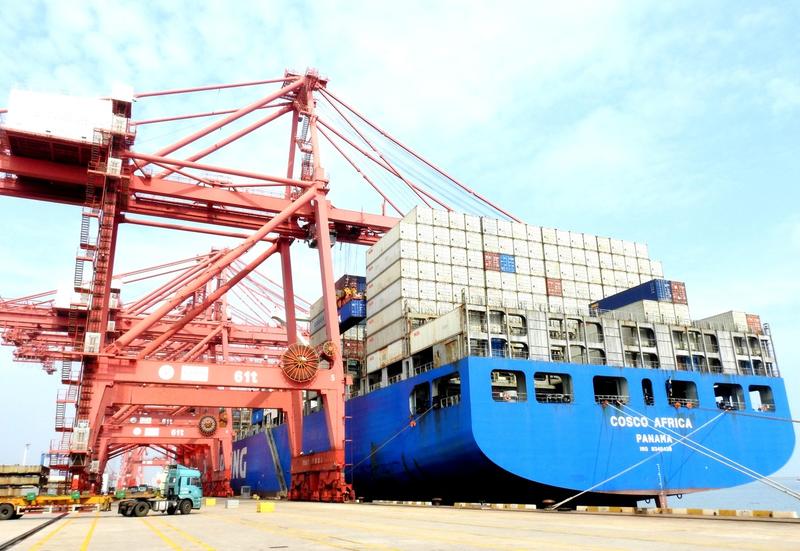 A container vessel unloads its cargo at a port in Lianyungang, Jiangsu province, on Tuesday. China's foreign trade has gradually recovered from the impact of the COVID-19 pandemic. (GENG YUHE / FOR CHINA DAILY)
A container vessel unloads its cargo at a port in Lianyungang, Jiangsu province, on Tuesday. China's foreign trade has gradually recovered from the impact of the COVID-19 pandemic. (GENG YUHE / FOR CHINA DAILY)
China is more than capable of stabilizing its foreign trade and promoting the high-quality development of imports and exports in the second half of this year, officials and experts said on Tuesday.
China's foreign trade rose 5.1 percent on a yearly basis in June, with exports up 4.3 percent and imports growing 6.2 percent
China's foreign trade rose 5.1 percent on a yearly basis in June, with exports up 4.3 percent and imports growing 6.2 percent, according to data released on Tuesday by the General Administration of Customs.
Despite the country's foreign trade being confronted by many uncertainties due to the COVID-19 pandemic and many countries' weak purchasing power, there was a notable surge in the country's manufacturing activities and trade last month, said Wei Jianguo, vice-chairman of the China Center for International Economic Exchanges.
June's trade data showed that global market demand is recovering and the country's export-oriented companies received more orders from foreign clients last month, especially from member economies of the Association of Southeast Asian Nations and countries and regions related to the Belt and Road Initiative, he said.
External demand will gradually pick up as other countries, such as the United States and France, started to boost their manufacturing and service sectors over the past two months. While the global industrial chain is in the process of reshaping, China's early economic recovery and complete industrial chain will help boost its exports in the second half, said Zhang Yu, chief analyst at Huachuang Securities.
China's foreign trade declined 3.2 percent year-on-year to 14.24 trillion yuan (US$2.03 trillion) in the first half of 2020, with the rate of decline falling by 1.7 percentage points compared with the figure in the first five months of this year, the GAC said.
ALSO READ: Foreign trade firms shifting to domestic market
Although the World Trade Organization predicted in April that global trade is expected to fall by between 13 and 32 percent in 2020, Li Kuiwen, the GAC's spokesman, said China's foreign trade in the first half of this year was better than expected, with both imports and exports registering positive growth in June.
China's exports of epidemic prevention and control supplies surged sharply between January and June. Its textile exports, including face masks, rose 32.4 percent year-on-year. In the meantime, exports of medical materials and medicines jumped 23.6 percent and those of medical equipment and devices rose by 46.4 percent, the customs authority said.
Li said China will continue to improve its export tax rebate policy, enhance supply and industrial chains, increase foreign trade credit placement, establish new cross-border e-commerce pilot zones and support export-oriented firms to sell more goods in the home market to help foreign trade enterprises overcome difficulties and secure foreign orders.
Chen Geng, chairman of Fuzhou-based Fashion-Flying Group, a large-scale outdoor garment manufacturer, said his company will partner with more cross-border e-commerce service providers and domestic e-commerce platforms, such as Tmall, to further diversify its sales channels in both the global and domestic markets. The value of its foreign orders dropped 20 percent on a yearly basis to US$80 million in the first half of this year, due to several clients canceling their shipments in the second quarter of this year.
Supported by over 17,000 employees at its manufacturing bases in China, Vietnam, Ethiopia, Rwanda and Bangladesh, the company shifted a part of its business from producing outdoor jackets and sleeping bags to protective clothing to offset losses from insufficient foreign orders between February and May.
READ MORE: Foreign trade will continue to play vital role in post-virus world
"As many countries have accumulated enough medical supplies, we only produce a small proportion of protective clothing now and will continue to make breakthroughs in product design and the innovation of new fabrics to secure our long-term global market share," said Chen, adding that the group's research and development department has been expanded to 200 employees this year.


